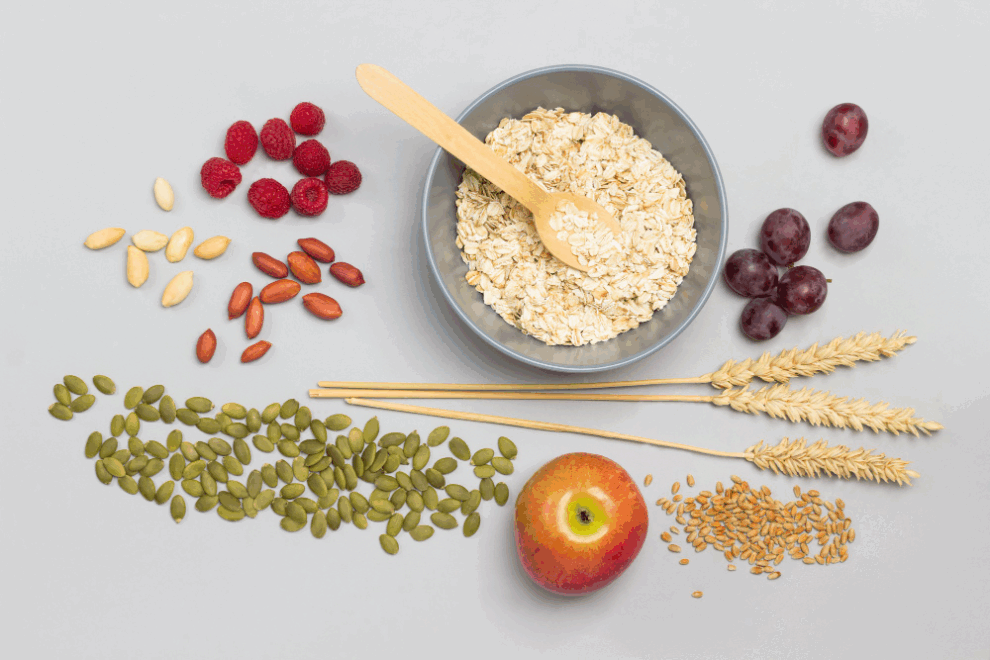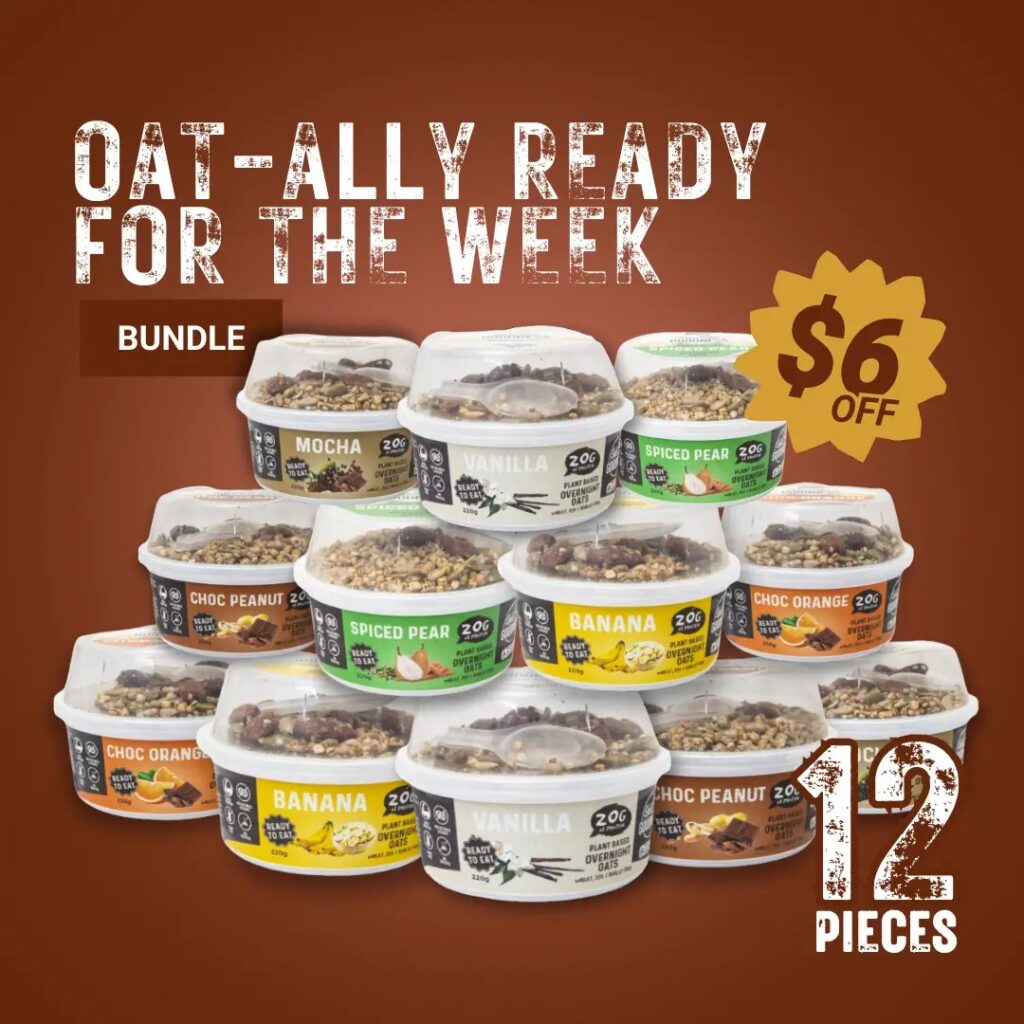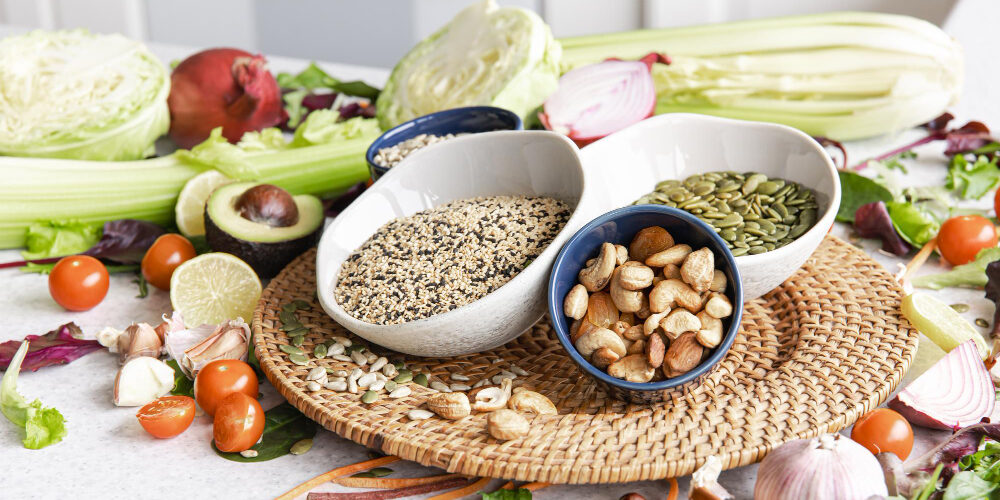Dieting is not easy for everyone. To lose weight healthily, you must consider every calorie intake and ingredient in every dish. Eating nutritious foods not only makes your body healthier and fitter even while on a calorie deficit, but it can also prevent you from gaining weight easily. Eating fibre foods for weight loss is the best solution for your diet plan!
Not only does it provide numerous benefits for the body, but it can also make you feel full longer, reducing the urge to eat larger portions. Here is an explanation of what fibre is, the types of fibre, and some food options you can consume for your diet plan!
What is fibre?

Fibre is a type of carbohydrate that slows down digestion in the body. It is commonly found in plant-based foods such as fruits, vegetables, whole grains, and legumes. Slow digestion in fibre foods for weight loss can make a person feel full for a longer period. There are two types of fibre: soluble and insoluble fibre, both of which offer many health benefits for the body. Consuming adequate fibre has the advantage of controlling blood sugar to be more stable, aiding weight management, and promoting healthy digestion.
What is the best type of fibre for weight loss?

When it comes to weight loss, not all fibres are created equal. The best types of fibre foods for weight loss are those that help you feel full longer and regulate your blood sugar levels. Here’s a closer look at the types of fibre that can support your weight loss journey.
Added fibre
Adding fibre to your diet can be an easy and effective way to support weight loss. It’s best to increase your intake to avoid digestive discomfort gradually. You can add fibre-rich foods like beans, lentils, vegetables, and whole grains to your meals. Fibre supplements like psyllium husk are also available, but should be used cautiously.
Dietary fibre
Dietary fibre is a type of fibre found in plant-based foods, essential for maintaining digestive health. It helps regulate bowel movements, reduces cholesterol, and promotes a feeling of fullness. Foods like whole grains, fruits, and vegetables are excellent sources of dietary fibre. Incorporating a variety of fibre-rich foods can also help reduce the risk of chronic diseases and manage body weight.
Insoluble fibre
Insoluble fibre does not dissolve in water but plays a key role in adding bulk to stool, which helps prevent constipation. It’s found in the skins of fruits and vegetables, whole grains, and nuts. This type of fibre helps keep the digestive system running smoothly and is beneficial for overall health. While it may not directly influence weight loss, it is essential for maintaining a healthy gut.
Soluble fibre
Soluble fibre dissolves in water to form a gel-like substance. It is effective in slowing digestion, which helps regulate blood sugar levels and prolong feelings of fullness. Soluble fibre is beneficial for weight loss as it can decrease appetite and reduce the urge to snack between meals. Foods rich in soluble fibre include oats, beans, lentils, and certain fruits like apples and citrus fruits.
High-fibre foods you should be eating
Overnight oats
Overnight oats are a wise choice for breakfast for everyone, whether you’re on a diet, a worker, a mother with busy mornings, or a child before they get ready for school. Not only are they convenient, but you don’t need much time to prepare them. They are also packed with numerous benefits, such as high protein, fibre, minerals, and vitamins. You can easily get a morning energy boost after consuming overnight oats.
Bananas
One fruit that is perfect for dieting is bananas! Not only are they high in vitamins and minerals, but they also provide natural sweetness without having to consume sugar. Therefore, you can use overnight oats with banana to enhance the overall flavour! The high fibre content in bananas also makes people who consume them feel full longer.
Granola
Granola always adds a crunchy texture to every dish, allowing you to experience a twist of flavour and a fun experience when adding granola to other ingredients. Besides being delicious, it is also packed with many nutrients, such as fibre, which supports digestive health and aids in weight management. You can use granola in various dishes, but many people combine it with yogurt as a snack or dessert.
Chia seeds
Chia seeds are also a very versatile ingredient that goes well with other ingredients. It allows you to create many new menu items for diet options that will certainly not be boring. You can add chia seeds to overnight oats, make chia pudding, or even other kinds of desserts. Chia seed overnight oats are also a high-fibre ingredient, making them a healthy and filling food.
Cauliflower
Cauliflower is a low-calorie food and one of the fibre foods for weight loss. It is a versatile ingredient that can be used in a variety of dishes, from cauliflower rice to roasted cauliflower. It is rich in both soluble and insoluble fibre, helping to regulate digestion and support gut health. Additionally, cauliflower is packed with vitamins and antioxidants, making it an excellent choice for overall health.
Sweet potatoes
Sweet potatoes, as a fibre food for weight loss, are not only delicious but also provide a warm feeling when consumed. They also offer both soluble and insoluble fibre, especially when eaten with the skin. They also offer various other nutrients such as minerals and vitamins, making them a whole, packed nutritional food! You can consume them as part of your diet because sweet potatoes are healthy, delicious, and very low in calories.
Almonds
Almonds are very versatile and go well with a wide variety of foods, always adding a nutty flavour and crunchy texture to every dish! However, almonds are a great source of fibre, healthy fats, and protein. The wholesome ingredients found in almonds make them a great option to consider for your daily diet!
Lentils
Lentils are one of the best sources of plant-based protein and fibre. They are rich in both soluble and insoluble fibre, which aids in digestion and helps control appetite. Lentils can be used in soups, stews, salads, and even veggie burgers. Their high fibre content makes them an excellent addition to any weight loss diet, helping you feel full and satisfied.
Dark chocolate
Dark chocolate is a favourite among many people. Many people believe that eating chocolate means consuming foods high in sugar, making it an unhealthy choice. However, dark chocolate has a lower sugar content and is also relatively high in fibre, especially varieties with a high cocoa content (70% or more). It makes dark chocolate a healthy dessert option that is quite beneficial for the body when consumed in moderation.
Brussels sprouts
Brussels sprouts are a high-fibre vegetable that can aid in weight loss. They are rich in both soluble and insoluble fibre, which promotes digestive health and helps keep you full. These mini cabbages are also packed with essential vitamins and antioxidants, making them a nutritious choice for your meals. Roast, steam, or sauté Brussels sprouts for a healthy and fibre-rich side dish.
Pros of using fibre for weight loss
It helps slow down digestion
One of the advantages of consuming foods that contain fibre is that it helps slow down digestion in your body, allowing for better nutrient absorption and helping to maintain a steady blood sugar level. This makes it a healthy and safe food to consume over a long period of time. However, fibre will provide many benefits for the body if consumed in moderation, so make sure to consume fibre in moderate portions.
It helps fill you up
One of the significant challenges in dieting is resisting hunger and cravings for excessive food or snacks. The solution to this problem is to consume foods that are high in fibre and keep you full longer. It would be better to consume them in the morning, such as overnight oats, to get a lot of energy to start your day, and also keep you full for a long time.
It helps keep your blood sugar in check
Fibre is well known for its ability to control blood sugar by slowing down the absorption of sugar into the bloodstream. It is really beneficial and healthy to consume, especially if you have high blood sugar levels. In addition, it can also help people diet more easily because maintaining stable blood sugar levels will make you feel full longer and not get hungry easily. Therefore, fibre is widely recognised as the best solution as an ingredient for dieting.
Cons of using fibre for weight loss
It can mess with your ability to absorb specific nutrients
Because fibre is a type of food that slows down digestion, consuming too much of it can lead to nutrient absorption issues. High-fibre foods can bind to certain minerals, such as calcium, iron, and zinc, making them less available for absorption by the body. Therefore, understanding the right amount of fibre for your body will help you overcome this problem. If you consume foods with moderate fibre content, there is a lower chance that they will absorb specific nutrients.
It can make you gassy and bloated
Consuming high levels of fibre can make you feel uncomfortable due to bloating and gas, especially when you eat beans, lentils, and certain vegetables that are high in fibre. However, not all high-fibre foods will cause bloating, and there are several ways to minimise gas and bloating. Drinking more water more often will help you reduce the effect.
Frequently Asked Questions
How to determine how much fibre you need to lose weight?
The recommended daily fibre intake for weight loss typically ranges from 25 to 30 grams for adults. However, individual needs can vary depending on age, gender, and activity level. A higher intake of fibre may be necessary if you’re more physically active or have specific health conditions.
How can I increase my fibre?
Increasing your fibre intake is simple by incorporating more high-fibre foods into your diet. Start by adding more fruits, vegetables, legumes, whole grains, and nuts to your meals. Foods like beans, lentils, oats, chia seeds, and berries are excellent sources of fibre.
How to incorporate fibre into a comprehensive weight loss plan?
Incorporating fibre into your weight loss plan is an excellent strategy for managing appetite and promoting digestion. Start by including high-fibre foods like vegetables, legumes, fruits, and whole grains in each meal. Fibre helps you feel full and satisfied, making it easier to stick to a calorie-controlled diet.
Conclusion
Fibre is an essential component of any weight loss plan, offering numerous benefits such as promoting satiety, regulating blood sugar, and improving digestion. By including more fibre foods for weight loss, you can support your diet goals while also enhancing overall health.
If you’re ready to boost your weight loss journey with fibre-rich foods, explore our full range of nutritious products on Oats My Goodness. Start making healthy, fibre-filled choices today!








